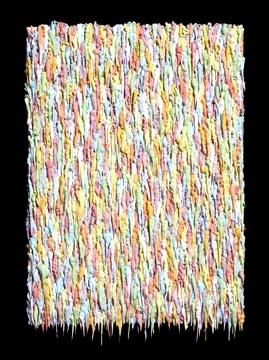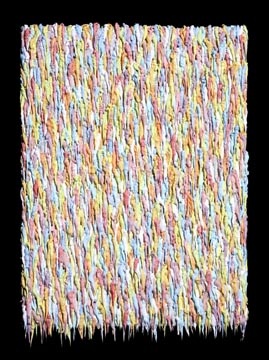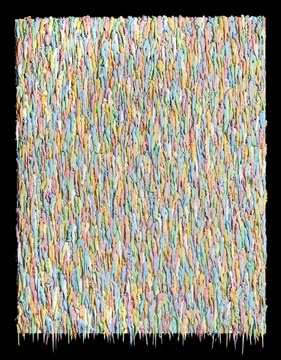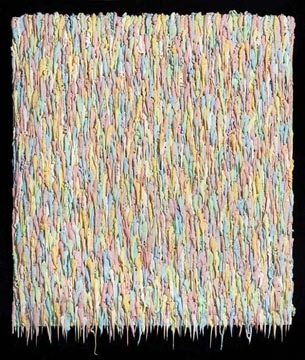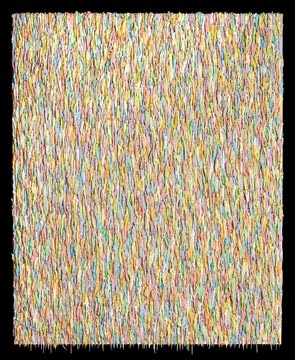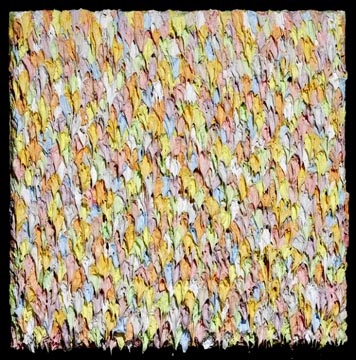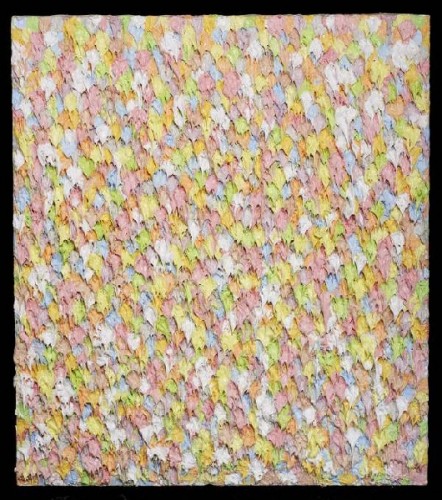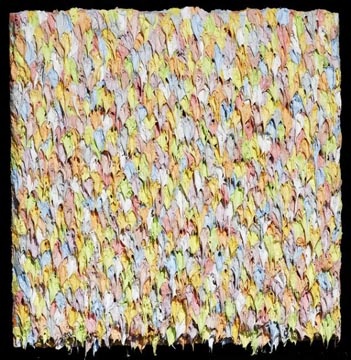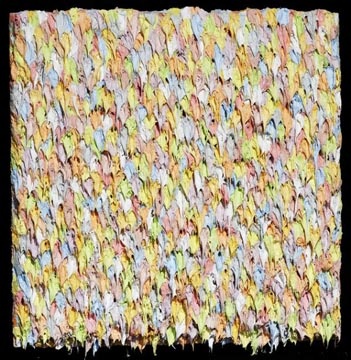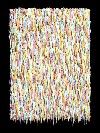Portfolio: Martin Mugar
The Persistence of Memory
By: Martin Mugar - Jan 11, 2008
Camp on Canvas: Martin Mugar
By Rosanna Warren (originally appeared in Provincetown Arts Magazine)
"My painting is about the desire that underlies the facts," writes Martin Mugar in the handsomely illustrated announcement for his recent show of Oil and Wax series paintings at Suffolk University. The verb "underlies" provides one key to this enigmatic and sensuous new work: the fatty tissue of Mugar's strokes springs out from the canvas, introducing a third dimension to this art of the flat surface, and teasingly suggesting the presence of a truth under the visible evidence. "Facts," provides another key. Considering Mugar's evolution from the still life paintings of the 1980's through the Hofmannesque Abstract Expressionism in the 1990's and into his new color field phase, we are led to ponder the different sorts of "facts" that painting proposes. And, "desire." That word is not carelessly printed on Mugar's announcement with its luscious, sherbet colors. Nor, for that matter, is the word "painting." These days it takes either a very naïve or a boldly sophisticated artist to put brush to canvas. Mugar is of the latter breed.
He loves the brush, and the delicate materiality of paint, and the symbolic properties of light and shape. An early still life from 1984 shows his allegiances: behind the blockily painted, laterally displayed cups, jugs and conch shell, and in the subdued tones of ivory, cream, granite grays, and umber, stand Chardin and his later interpreters, Cézanne and Derain. Mugar's brushwork here is forceful, and most of all one notices the subtle distinctions in hue and value on the busily articulated tablecloth, the sides and shoulders of the objects.
Two years later, in "Still Life 1986" shown at the M. I. T. Museum, Mugar has declared a certain independence. This is no longer homage or canny apprentice work. Table top, room, and objects have been severely reduced, and the palette has lightened to a kinky range of pinks, lavenders, mustards and crocus green. In their simplified shapes, the three discernible cups or jugs are no longer presented with any gesture toward three-dimensional illusion; they hover as sculpted cloud shapes in the dense atmosphere of the painting in which solid matter and air share the same molecular formula.
In the 1990's, Mugar moved into a phase he calls his Abstract Expressionism. At his own pace, thoughtfully, privately, he worked his way through the idioms and evolution of Modernist painting, years in arrears of the path-breakers DeKooning, Pollock, Hofmann, Guston et al., but proving the integrity of his own shape-making and of his translation of the tradition into his own terms. Mugar's paintings from the 90's are exuberant affairs. Often five or six feet wide and high, painted in bold, risky, but controlled strokes, these works often suggest landscape while disturbing spatial logic and playing depths against abrupt blockages of foreground. "Self in Landscape" of 1990 depicts no "self," but some swashbuckling black calligraphy outlines a slender central rectangle within a larger frame and arranges a perspective reminiscent of an outside scene—mounds of juicy foliage and hillish backdrop, with a deep cobalt swatch of sky above—perceived through a window. The window itself seems to be promenading through outdoor-space, not attached to any indoor architecture. The two awkward calligraphic rectangles might be taken as focusing devices, and thereby as a mark of an organizing human vision—the "self" in the landscape. "Still Life" (1989) proclaims itself, in its wadded block-like shapes, a kind of assemblage of objects crowded on a table top, perhaps beneath a window sill above which succulent green stalks and a golden background are visible. The painting permits no conventional reading of objects in gravitational space, however; planes of color—the cerulean cloud in the foreground, the salmon pink box astride it—announce their own proud color and texture rather than "objectness."
By the late 90's, Mugar has cut loose still further from referential conventions. "Mulch" (1996) shares a gestural language with "Mackerel Crowded Seas" (1997), so the titles no longer serve a descriptive function so much as an obliquely symbolic one. In both of these large paintings, a massive central cluster of drippingly brushed ovals dominates the surface. In "Mulch," this Easter egg fantasia emerges from a background of slurpy, billowing cream, salmon and mustard, while the eggs themselves are outrageously striped in peacock blue, lemon, rose and burnt sienna. "Mackerel Crowded Seas" (the phrase from Yeats' poem "Sailing to Byzantium") suggests nothing fishy in its crayola-flesh cluster of ovals and trailing tentacles, except perhaps a dream of explosively fertile fish eggs. In both of these paintings and their weird coloration, a strong element of camp and of willed vulgarity generates a peculiar energy.
Around 2000, Mugar's work took a significant turn. As he has described it, "The third period is a stepping out of the push-pull of self and group and is a painstaking sensitizing of every mark, every stroke out of which is created a purer self." Purer self or no (a matter impossible for an outsider to judge), these new paintings, including the Oil and Wax series shown last fall at Suffolk, have radically changed their focus and their organization of incident. They present a unified surface of repeated gestures, symmetrical drips, in a limited chromatic range. They flaunt bubble gum and sherbet colors: strawberry, pale lime, baby blue, café au lait, tangerine cream, lemon ice… To distinguish one painting from another and to read each individual painting, one finds oneself peering hard at the facture of the strokes. Some of the paintings have a tighter weave than others; some allow more ragged drip at the base of the canvas; some allow one color (say, pink) to predominate in the quasi-pointilliste scheme, while others yield (say) to lime.
Let us take, for example, a pinkish 36 by 40 inch painting from 2003. Because the wax thickens the oil pigment to an almost sculptural medium, Mugar is able to energize the surface not only by chromatic variation across the surface, but in the goopy three-dimensional events that add the further graphic element of shadow. In the 2003 canvas, a considerable downward tension is provoked by the gobs at the top of the canvas that initiate the downwardly overlapping leaf shapes. In the main pattern, the elevated strokes, tightened by wax, cast shadows beneath their scales and stalactite drips, so that suddenly this light-hearted weave is complicated, in mood, by shade, the dark underlining of each stroke, the suggestion of secrete depths and cavities. The bottom edge has an even more sinister development: the final smears protrude beyond the border, leaving a ragged bottom with bits of bare canvas exposed. Some kind of illusion is broken here, about the tidy, sugary harmony proposed by the whole painting. That order is revealed as produced by a process, possibly a violent one, capable of dissolution.
Scanning the works in the Oil and Wax series for their small but significant differences becomes a lesson in seeing. They all enjoy a democracy of stroke and color. But then a tiny irregularity will announce itself—such as the small salmon scale with no overhang just below the center of the small square from 2005—and become an event that affects the entire composition.
At times these strokes suggest leaves, at times scales, at times electrons. They seem to argue that reality is composed of an underlying geometric regularity. And it appears a celebratory regularity, funky and outrageous in hue. Celebratory, that is, and even pretty, until the unnaturalness of the colors become alarming; and until we note the shadow schemes and border clots that tell a more disorderly story. With this new series, Mugar has invented a mode that is entirely his own. It has visual and tactile authority, a high degree of craft (something one no longer necessarily expects from art presented in public), and a powerful metaphysical suggestiveness. It is intelligent, sensuous painting that has kept faith with its traditions and has at the same time registered an original mode of seeing for our age of quarks and fractals.
http://homepage.mac.com/martinmugar/Menu48.html

